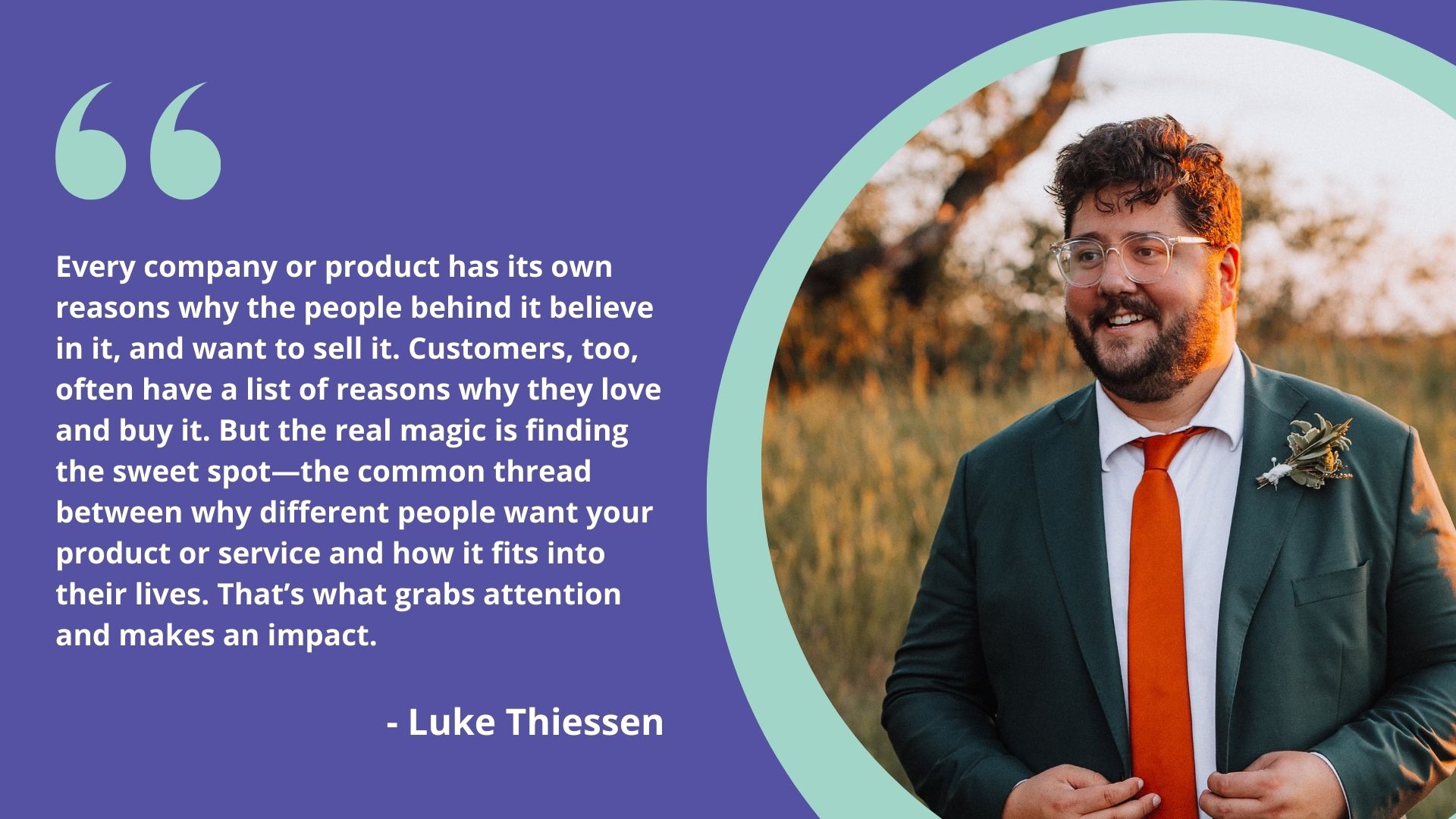Tagged: advertising
Meet Luke Thiessen
- by Alicia Kurz
Let’s just start by saying the quiet part out loud: we did not expect that a straight, cis, white, Christian male would be the perfect person to take over Alyson Shane’s duties at Starling Social. But, after getting to know him, we’re confident you’ll be as happy about it as we are.
“Happy” is a strange word to use because we are all having a lot of feelings right now. We’re figuring out it’s okay to feel a little happy mixed in with everything else. Maybe the more correct word is “right.” Luke coming on board feels like the right decision for Starling Social.
Who Is Luke?
The first thing you need to know about Luke is that he is starting a Taylor Swift drag cover band with John Luxford. Okay, maybe that’s not the first thing you need to know, but it is important information, and we will be sharing show details when it becomes available.
Luke is a long-time, trusted and close friend of Alyson’s. The two met during a work placement at Direct Focus, where Alyson was working at the time, and then reconnected on Twitter — back when it was still a good place to be.
Wanting to get into similar work, the two became fast friends, bouncing ideas off of each other over a craft beer and cheering for the other’s successes.
You may have seen Luke at one of Manitoba’s many music festivals or even playing in his own band! He is drawn to folk, Americana and blues music — but he also loves a good bop. Luke’s other hobby is brewing beer and he’s a proud member of the Winnipeg Brew Bombers.
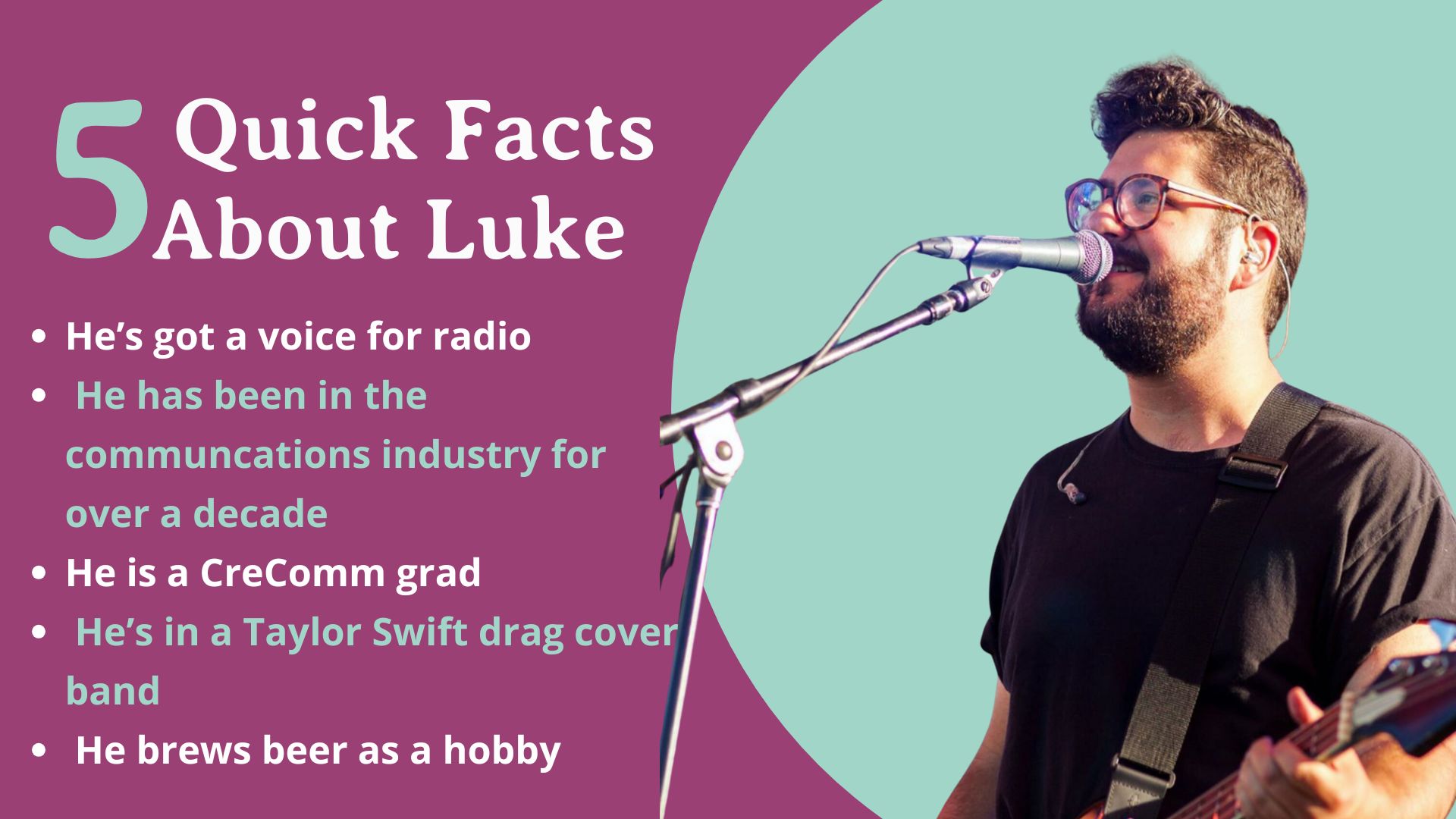
Work Life
After graduating from Red River College’s Creative Communications program in 2014, Luke secured a job at his second internship, Golden West Radio — a network of (mostly rural) radio stations with a couple of spots based in Winnipeg.
When you hear Luke’s voice, you immediately agree that it belongs on the radio, so it was no surprise that he was asked to start part-time and cover the news. That quickly turned into a full-time position on Classic 107 and across other Golden West radio stations.
Luke says doing the news was never his dream, so he transferred to another station and secured a spot as an afternoon drive show host. In that position, he led the content creation and the on-air team. That included things like coming up with partnerships for advertisers, delivering on-air content, running a show, and coming up with timely and entertaining things to talk about.
Interested in doing and learning more, Luke started doing freelance communications and publicity work with a local record label.
“After about a year I took the leap, quit my day job and started doing freelance full-time.”
Most of his clients were in the arts and music scene, but he also did communications work for non-profits and small businesses. In the initial years of Starling Social, Alyson hired Luke to manage some content marketing projects.
Luke made a great impression in the communications field and was offered a job at Siloam Mission as the Manager of Communications, where he spent the next 6.5 years.
At Siloam Mission, Luke helped grow the communications and marketing department from a team of one to a group of four. They handled everything from public relations to digital marketing to fundraising materials.
“Over that time, we brought a lot of that work in-house or changed our vendors to local vendors, like Starling Social. Whatever we couldn’t do in-house, we wanted to at least have close to home, so that’s when we started working with Starling.”
If you didn’t know, Siloam Mission became one of Starling’s clients in 2022.
In November 2023, Luke left Siloam Mission to take a break, do some work in the craft beer world, and start his own freelance practice. His business was just starting to come online when Alyson passed.
If you’ve interacted with our team before, you’ll know we’re a bunch of self-starters with good intentions. Through our grief, we each contributed to creating spreadsheets of outstanding tasks, making tough calls, and writing whatever needed to be written. We felt it was important not to add more to John’s plate, for our clients to have no interruptions in service, and to treat this company with the same respect Alyson showed us. After a couple of weeks and some discussion, a team member phoned Luke and pitched the idea of him coming on board.
“It never occurred to me that this was something I should think about doing. But it immediately clicked for me. We had a discussion, and I thought, as long as everyone wants this to happen and feels the same way, then this feels like such a natural fit.”
While we all mourn the circumstances that brought us here, we also feel Luke has the experience, skills, and values we want to run Starling Social — and the extroverted personality to grow it. His personal and working relationship with Alyson gave him insight into how the company is run, and we are grateful he has stepped in to fill this position so Starling Social can continue to thrive.
Joining Starling
Luke’s goal is to add to the company, not change how it's run. He wants to see what else he can bring to the table for clients to make their experience even better.
“I am looking forward to digging back into the work that I’m passionate about. To meet new clients and get to know their stories and their people. I’m a people person. I’m an extrovert, and that gives me energy.”
Luke loves working on big-picture ideas and creating new strategies. As an “ad guy", he’s driven to create campaigns that tell the story of a product, brand, project, or capital campaign. He loves getting into a brand or campaign with a great story to tell.
Publicity and media outreach is a large piece of Luke’s background and a new service he is proud to offer Starling clients.
“I've always been so proud of Alyson and the work she’s done at Starling. It’s been amazing to watch the business grow and, by extension, see her clients do well. This opportunity just feels really exciting and I’m honoured to be able to continue that and do some of that same great work.”
If you have questions for Luke, or are interested in ramping up your digital marketing game in 2025, contact us here.
How To: Create Facebook Lookalike Audiences That Deliver Results
- by Alyson Shane
Hey there! This post was originally published on December 2017, but has been updated as recently as September 2020.
Are you looking to connect with more customers and increase leads for your business?
Are you wondering how to use Facebook Audiences to create Custom Lookalike Audiences?
This post will be your guide! In our first post about Facebook Custom Audiences we shared how to choose the right Custom Audiences for your Facebook ads, but this one will go into one of the most powerful tools at your disposal when you use Facebook Ads: Facebook Lookalike Audiences.
What Are Facebook Lookalike Audiences
Lookalike Audiences are audiences created from the profile data you've previously uploaded when creating your Custom Audiences.
Facebook will use the profile data from these audiences to create a new list of Facebook users who share similar demographics and interests. This is a super-reliable way to optimize your campaign targeting and make sure that you're not just re-targeting the same people from previous campaigns.
Lookalike Audiences allow you to take a relatively small sample size (10,000 customers, for example) and create "lookalike" audiences comprised of hundreds of thousands of people.
Before we get started, you'll need to have the following prepared and in-hand:
- Access to your customer lists (emails or phone numbers), usually pulled from a system like MailChimp, or Shopify for our e-commerce friends.
- Facebook Conversion Pixels set up on the pages you want to track results for.
- The visual assets, headline and ad copy that you want to test*.
* We recommend using at least 2-3 of each, which will allow you to test how different combinations of words and text perform with your audience.
Let's get started!

1. Open your Business Manager and click on the "Audiences" option under your Assets column.
2. Select 'Custom Lookalike Audience' from the drop-down "Create Audience" menu.
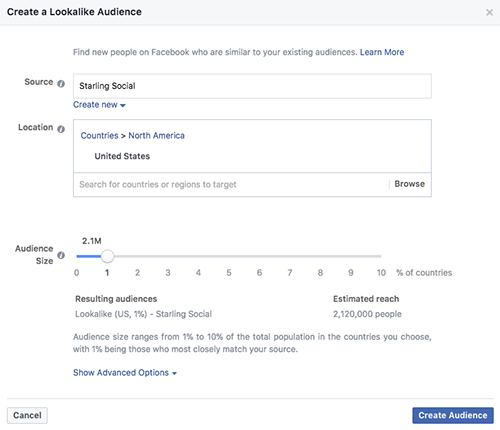
3. Select the Audience Size you'd like to target. We recommend creating two versions of the same custom audience: one at 1% and 3%, which will allow you to target users who most closely match your original Custom Audience, as well as a broader audience of users who may not be as close a "match" as the 1%.
4. Click "Create Audience" and wait while Facebook matches users and populates your new list.
5. Once this process is complete (it may take a few minutes) open up your Power Editor and begin setting up your Ads as you normally would. When setting up your targeting, just select your new Lookalike Audience from the drop-down menu:

... and that's it! Now you can take your visual and content assets and begin setting up your Facebook Ads like you normally would.
Using Lookalike Audiences to Increase Sales
Now that you've learned how to create your own Facebook Lookalike Audience, it's time to begin using it to drive conversions... starting now!
Here are a few ways you can leverage the power of your audience:
Grow Your Facebook Page
One of the easiest ways to grow your Facebook Page is to target one of your Lookalike audiences. This allows you to save time and takes the guesswork out of targeting new users who may not have interacted with your page before.
Increase Sales for Your E-Commerce Store
If you run an e-commerce store you can set up Facebook Ads that deliver to your Lookalike Audience which sends them directly to your website to start buying.
For example, if you have a women's wear section on your website you can create a Custom Audience of only women, then you can use Lookalike audiences to deliver ads to women who closely match interests or demographics of the women who have completed a purchase.
Increase Subscribers, Signups, and Get Leads
The fastest way to turn a lead into a customer is to increase the amount of interactions they have with your brand. Examples of "interactions" can include:
- Answering a survey
- Filling out a form
- Subscribing to a mailing list
- Downloading a piece of content
This tactic is similar to what an e-commerce website would do: upload a Custom Audience, create the Lookalike Audience, and then send people directly to a landing page on your website specifically set up to encourage them to take the action you want them to take.
Get started!
Now that you know how to set up and use Facebook Lookalike Audiences, it's time to start implementing them as a routine part of your Facebook Ad strategy. If you still have questions, drop us a line or connect with us on Facebook, Twitter, LinkedIn, or Instagram. We're always happy to chat.
Everything You Need to Know About Podcast Advertising
- by Alyson Shane
Are you trying to figure out if podcast advertising is right for your business?
Podcasts have become insanely popular these last few years. Over 1/2 of all Americans have listened to one, and nearly 1 in 3 people listen to at least one podcast every month.
Last year, it was more like one in four.
As a result, businesses are projected to spend over $500 million on podcast ads by 2020.
Why? Because 75% of podcast listeners actively listen to podcast ads, and are likely to follow a specific call-to-action after hearing it.
In this post, we'll cover the basics of podcasting, and share the key things to consider when planning your podcast advertising strategy.
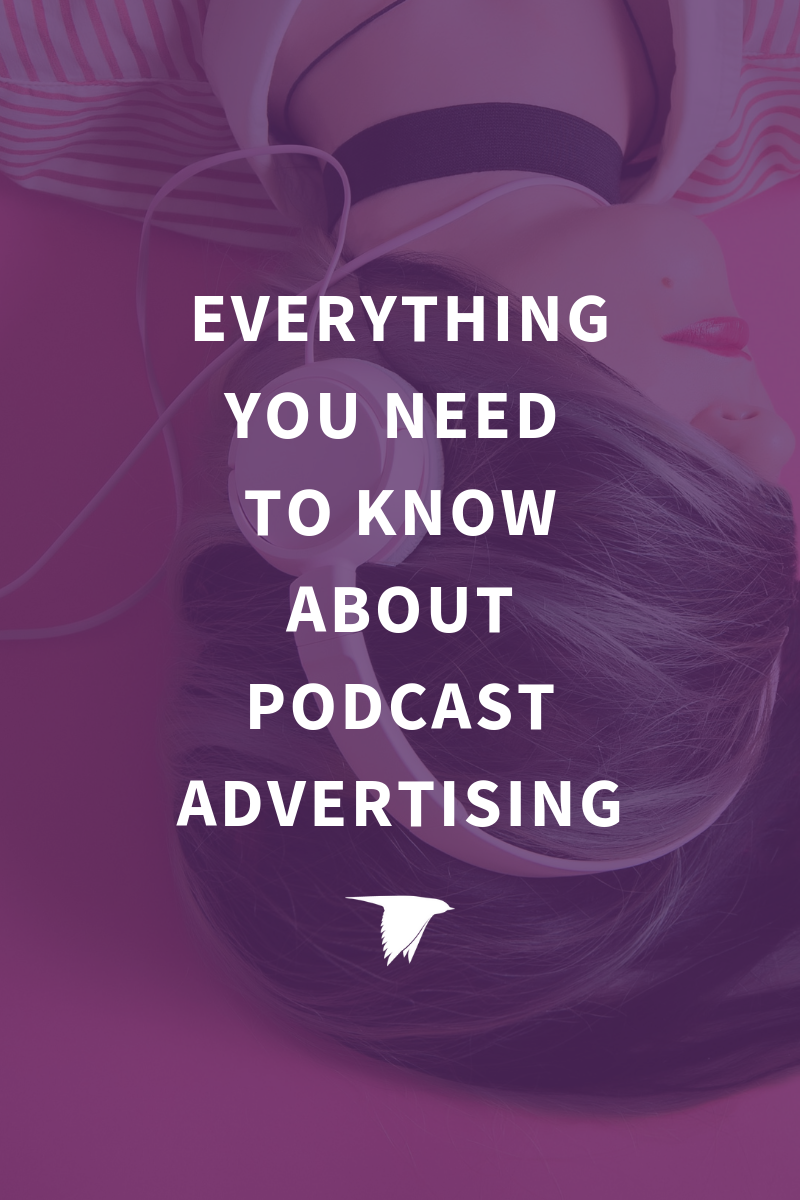
Podcasting Terminology 101
If you're fresh to the world of podcasting, here are a few key terms you need to know before we dive in:
- Pre-roll: an ad that plays at the start of the podcast.
- Mid-roll: an ad that plays in the middle.
- Outro: an ad that (wait for it) plays a final call to action before the podcast ends.
- Offer code: a code included in your call-to-action to track where signups, downloads, or purchases come from.
- Native ads: ads hosts read as part of the natural flow of their shows.
- Direct response: URL or offer codes for podcasts that can be tracked.
- Cost per Mille (CPM): how to measure the ad expense per 1000 podcast listens.
- Cost per Acquisition (CPA): how to measure how much it costs you to acquire a new customer through an ad.
How to Find the Right Podcasts for Advertising
Think Like Your Customers
Before you invest in a podcast ad, think about the kinds of people who are most likely to become your customers. This is a great time to break out your buyer personas, but if you don't have any, ask yourself some of these questions:
- Am I advertising to men, women, or both? What are the demographics of my ideal customer (age, income, spending habits)?
- What are the demographics of my ideal customer (age, income, spending habits)?
- What do the podcast hosts have in common with your customers?
Get Real Endorsements from Podcast Hosts
One of the best things about podcast advertising is you can offer samples of your products or free use of your services to the hosts themselves.
Samples create the opportunity for hosts to give a real, honest testimonial about how your company improved their life. These testimonials sound honest because they are honest.
They're why 38% of people who listen to podcasts have reported buying products or services mentioned on podcasts.
Choose Your Podcast Ad Type
There are two categories of podcast ads, which are:
Dynamically Inserted Ads: Ads inserted into a podcast after recording. These ads change depending on when the podcast is played, among other factors.
Dynamically inserted ads are great for targeting specific listeners with a standalone ad that can be tracked and measured.
Baked In Ads: As the name suggests, a baked in ad is read live by the podcast host and isn't inserted after the podcast has been recorded. Everyone who downloads the podcast hears the same ad.
These ads create a more organic feel, but can be difficult to track due to a lack of targeting.
Dynamic ads are a great way to A/B test two versions of your ad messaging with the same audience. These are also better for time-sensitive specials and offers, since you'll want to swap them out with different ads after.
Deciding How Much to Spend on Podcast Ads
Before you start spending, ask yourself these questions:
- What's my goal and how will I track it? (eg: signups, downloads, calls)
- What is my total budget?
Not sure how to calculate a podcast advertising budget? Think about is this way:
According to AdvertiseCast, and the average industry rates for podcasting are:
- $22 for a 30-second ad CPM
- $26 for a 60-second ad CPM
Your CPM goes up depending on how many people listen to the podcast, so if you're hoping to buy a 60-second spot you can expect to pay around $1500 to advertise on a podcast that has 10,000 listeners.
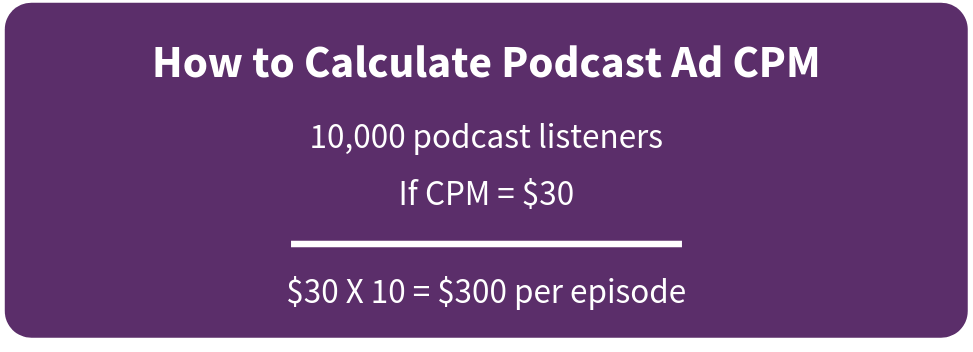
Though some podcasters charge a flat fee, most use either a CPA or CPM formula to set their rates.
For example, if a podcaster's CPM is $30, you'll pay $30 for every thousand unique downloads of the episode where your ad plays. If the podcast has 10,000 listens per episode, your CPM will be $300 per episode.
As a result, advertising on smaller, niche podcasts is great if you're just getting started.
Use the formula above as a reference to determine how much you can afford per episode of each podcast you'd like to advertise on.
Measure + Track Ad ROI
There are a few ways to track how well your podcast ad is performing, including:
Custom URLs: Include a custom URL in your ad that's easy to remember, and directs visitors to a custom landing page designed specifically for the ad campaign.
Promo Codes: Include a promo code for listeners can use when they complete a purchase on your website. You can use multiple promo codes to track different ad campaigns at the same time.
Surveys: Ask buyers or subscribers how they heard about you at checkout, or in a capture form.
Start Small and Experiment
The best way to start podcast advertising is by experimenting with modest budgets. Find smaller, niche podcasts about topics your customers care about first.
Begin with a few tests to understand works, and what doesn't, and don't be afraid to try something different.
Want more information like this sent right to your inbox every week? Subscribe to our newsletter for hand-picked stories and marketing news you care about.
Lessons From Netflix's Super Bowl Ad for The Cloverfield Paradox
- by Alyson Shane
Even if you don't watch football, the results of last night's Super Bowl LII should have left you with your jaw on the floor.
No - we're not talking about how the Eagles pulled ahead at the last minute thanks to the touchdown pass caught by QB Nick Foles; we're talking about Netflix's surprise ad and movie release for The Cloverfield Paradox.
For those of you who may have missed it, Netflix sprung a trick play on audiences by investing in a highly-coveted Super Bowl ad for the latest installment in J.J. Abrams' sci-fi franchise Cloverfield: The Cloverfield Paradox.
The ad, which aired during the second quarter, ends with text which reads: "coming very soon" which was followed by an announcement from Netflix stating that they would begin streaming the film online immediately after the game.
Naturally people began freaking out about it online, hailing it as one of the most innovative ways to market a box-office film ever. Netflix's edgy, innovative strategy upended traditional assumptions about how movie advertising is done, and it's likely that things will never be the same.
Even if you're not in the business of making movies (also called "show business") there's a lot brands from other industries can learn from Netflix's groundbreaking move.
Let's explore:
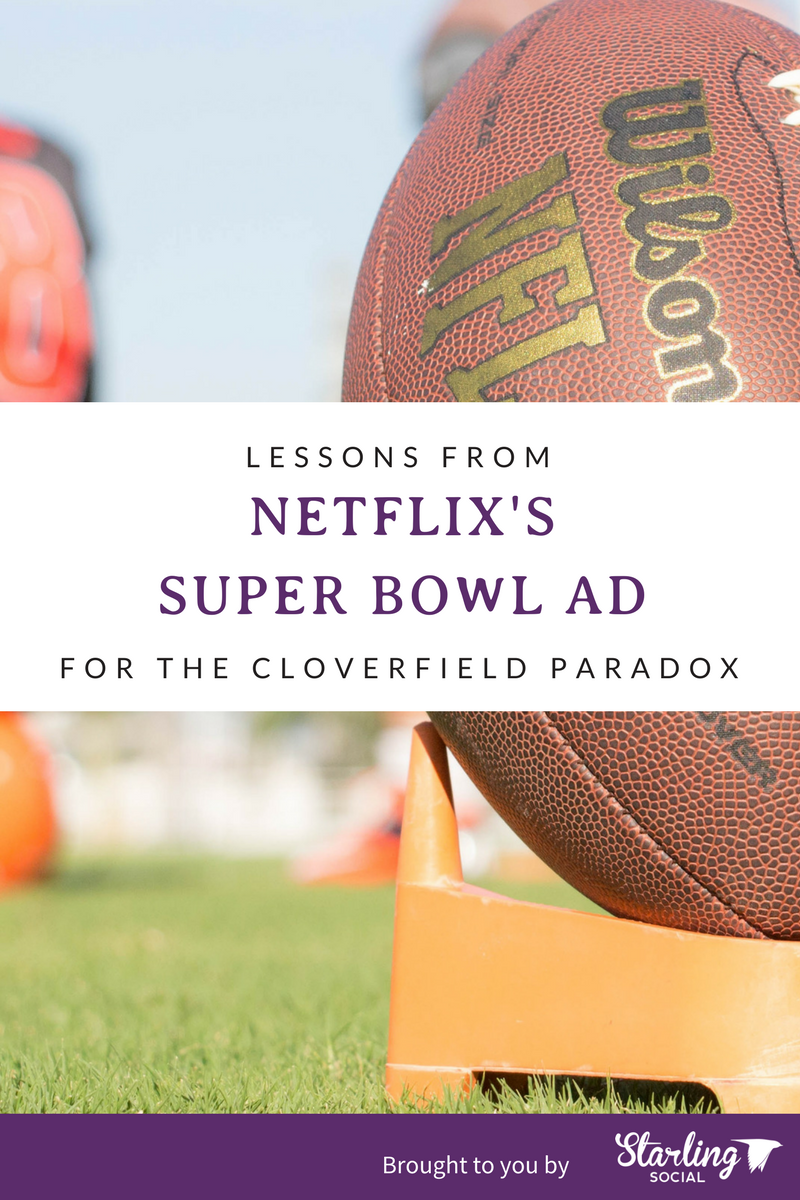
Experiment With Your Approach
We all know that buying a Super Bowl ad is one of the most effective (and expensive) ways to showcase your brand, product, or service to a captive audience of millions. In fact, it's not uncommon for movie studios to drop ads for upcoming theatrical releases during the Super Bowl.
What makes Netflix's approach different is that they barely gave their audience time to react to the ad before the movie started streaming. By breaking with the tradition of releasing teaser trailers, real-world ads, multiple full-length ads, and other traditional marketing tactics, Netflix broke the mold on traditional movie and TV advertising and gave audiences exactly what they wanted within hours of showing it to them.
Netflix took advantage of the energy, excitement, and captive audience generated by the Super Bowl and channeled as much of that engaged audience as possible into their digital streaming platform as soon as the game was over.
Your Takeaway
Don't be afraid to surprise your audience. We love the unexpected, especially when it comes to advertising, and breaking with tradition and experimenting on an ongoing basis will not only help you develop a better understanding of what your customers or clients behave, but you'll keep them on their toes which will keep them as engaged with your brand as possible.
Experiment With Audience Conversion Tactics
"You can't advertise during the Super Bowl and expect people to watch your movie right after!"
What do you think the odds are that someone, at some point throughout planning this campaign, said this? Pretty likely, and it's because what Netflix did flew in the face of traditional audience conversion tactics.
Think about it this way: Netflix managed to draw in an audience of viewers tuned into an unrelated live event and converted them to their digital streaming platform immediately after the event ended.
This is a huge risk for advertisers, as we know that it can be hard to replicate marketing ROI success across different audience types (Facebook audiences react to different content than LinkedIn audiences, for example) but Netflix wasn't afraid to experiment with a new approach which encouraged audiences to turn off one streaming service (their digital package or cable provider) and turn to another - their own.
Your Takeaway
If you know you have a captive audience on another platform or digital medium and you need to find ways of converting them, invest in ads specifically for the purpose of funneling them to your site or platform.
Don't be afraid to encourage cross-platform conversions! Pay attention to when audiences on other platforms are most engaged, or are likely to be online, and direct your advertising dollars into ads that run during those peak times in order to capitalize on the existing, engaged audience like Netflix did.
Don't be Afraid to Experiment. Period.
This isn't the first time that Netflix has shaken up traditional TV and movie advertising tactics.
Back in 2013, they shocked audiences by dropping all 13 episodes of House of Cards at once, effectively ushering in the age of binge-watching and changing how most people consume media.
At the time it was considered a groundbreaking move, but several years on the practice has become so commonplace that many of us allocate weekends to "binge" one season of a show or another. This shows us that taking risks and changing up traditional models can not only result in ongoing publicity and media - something every brand wants - but can fundamentally shape how your clients and customers interact with your products or services on an ongoing basis.
Your Takeaway
TRY NEW TACTICS.
If there's anything that this article and Netflix's strategies should tell you, it's that being bold and trying new methods of advertising, sharing information, and audience conversions is the way of the future.
Most brands are finding it harder and harder to stand out online, and the only way to create a viral hit à la Netflix is to step outside of your comfort zone and spend some time experimenting with new and innovative ways of reaching your audience.
With this new Super Bowl ad and immediate release Netflix has once again shown a determination to challenge the assumptions of traditional advertising, and we can't wait to see where they go next.
What's your reaction to Netflix's ad for The Cloverfield Paradox?
Let us know by dropping us a line on Facebook, Twitter, LinkedIn, or leave us a comment on Instagram!
Choosing The Best Facebook Custom Audience for Your Business
- by Alyson Shane
Businesses are starting to wake up to the fact that, often, organic posting and engagement just isn't driving the traffic to their Facebook pages and Instagram profiles that it once did and are turning to Facebook Ads as a cost-effective way to get in front of hundreds or even thousands of new potential customers.
Here at Starling Social we've used Facebook Ads to help our clients increase webinar registration, generate new B2B leads, drive inbound website traffic, and more. We love it because Facebook allows us to dig deep and create Custom Audiences which help us retarget people who have previously engaged with our client's business in some way. This helps us keep their advertising budget low while achieving a high return on investment (ROI) for our efforts on their behalf.
If you're new to the world of Facebook Ads, or if you're still trying to wrap your head around which types of Custom Audiences you should choose for your next Facebook Ad Campaign, then you've come to the right place.
This post is a comprehensive overview on what Facebook Custom Audiences are, and the various types you can choose from to increase brand awareness and generate new leads for your business.
Ready? Let's get started!
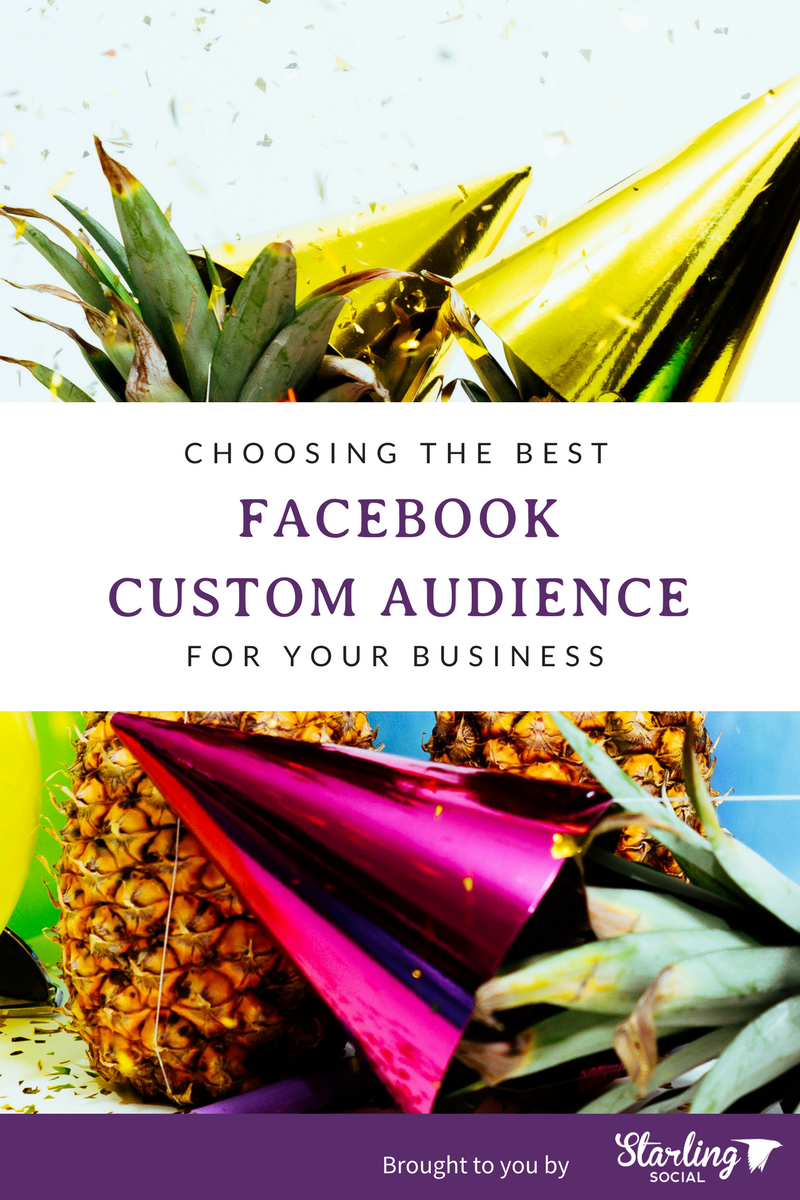
What's a Facebook Custom Audience?
Facebook Custom Audience is just that: a custom audience you can create in your Facebook Ads Manager (or Power Editor) that you can target with your ads. One of the options available is o target people who have an existing relationship with your business - say, fans of your Page - and create a campaign which retargets this audience.
Facebook gives you six options to define the existing relationship between your ad audience and your business, which are:
- Customer File. Upload a customer file (eg: list of individuals who have purchased from your e-commerce store within the past 365 days) to match your customers with people on Facebook to create an audience from the matches.
- Website Traffic. Create a list of people who visited your website or took a specific action which corresponds to your Facebook Pixel.*
- App Activity. Creates a list of people who launches your game, app, or took specific actions based on the Facebook Pixel installed in your app.
- Offline Activity. Upload a list of people who have interacted with your business in-store to create a custom audience based on phone numbers or other offline channels.
- Engagement. Creates a list of people who have recently engaged with your content on Instagram or Facebook.
* A Facebook Pixel is a code you (or your developer) installs on your website or in your app to track conversions from Facebook Ads and collect data to do stuff like build the Custom Audiences we're discussing here.
Let's sink our teeth into the different Custom Audience types available, and how they differ from each other:
Customer File Audiences
Customer File Audiences are based on a list of existing contacts available to you, such as newsletter subscribers or customers who have purchased from your e-commerce site. Syncing your customer list can be done one of two ways:
- Manually uploading your audience in a .csv or .txt file.
- Syncing your email CRM to your Facebook Ad Account.
Important: you can't mix data types, so you'll need to upload separate files for emails vs. phone numbers, for example.
We recommend giving your Custom Audience a short, easy-to-identify name which describes the specific audience, such as "Email signups" or "Past Customers."
Website Traffic Custom Audiences
If your business doesn't have a large enough database of emails, phone numbers, or Facebook User IDs to create a Custom Audience based on the steps above, you can use Website Custom Audiences to retarget visitors who have already visited your website.
This is a big boon for many businesses who are in the process of building their newsletter lists, for example, because all you need to do is make sure your Facebook pixel is installed and wait for people to visit your website. When they do, Facebook will recognize the users and automatically add them to an Audience, ready to be retargeted.
App Activity Audiences
With the explosion of mobile app popularity and Facebook mobile ads, it's no surprise that this option is becoming a popular solution for many app-based businesses.
The option allows you to target people who have previously used your app but haven't come back to use it within the last month (for example), or, you can target people who have abandoned their carts (added an item to their cart but never completed the purchase.)
There are lots of ways to retarget app audiences (currently there are 14 actions/non-actions you can target), but the most popular options are:
- Achieved a certain level in your game.
- Completed a large purchase.
- Recently opened your app.
- Recently completed a purchase.
By targeted users who have (or haven't) completed a specific action you can tailor your retargeting ads with copy and visual content which compels them to come back, such as new levels, discounts, or ads featuring new items for purchase.
Offline Activity Audiences
The Offline Activity option allows you to build Custom Audiences based on one or multiple offline events, such as Add Payment Info, Add to Wishlist, etc.
When you choose "Offline Activity" as tour Custom Audience type in Ads Manager, you can add multiple filters to refine the audiences to your specific needs. You can select multiple offline events and filters such as People Interacted Offline, Add Payment Info, Initiate Checkout, and more from the drop-down menu to restrict your list.
If you want to get super-granular, you can refine your data even further using the Custom Value or Aggregated Value options, which allows you to add conditions or values which are specific to your business goals. For example, you can add "source equals to call" to track the number of calls your business has received.
Engagement Custom Audiences
The Engagement option is especially exciting because it means you can use your ads to retarget people who have already shown an interest in your business on social media, which increases the likelihood that they will convert by 70%, according to FetchProfits.
If you click on "Engagement", a window will appear which will prompt you to define an Engagement Audience based on six different engagement types. They are:
- Video. This will target users who have watched at least three seconds of your videos on your Facebook Page or Instagram business profile.
- Lead Forms. If you already use Lead ads, you can get in front of people who have opened or completed your lead form.
- Fullscreen Experience. This option relates to the Facebook Canvas Ad option, and will retarget users who have opened your Canvas collection ads.
- Facebook Page. This is our favorite because it allows you to retarget anyone who has interacted with or visited you Facebook Page.
- Instagram Business Profile. This is similar to the Facebook Page option, but retargets to people who have interacted with your Instagram business profile.
- Event. Event retargeting is the latest addition to the Facebook Engaged Audience family, and allows you to retarget people who have RSVP'd to an event on Facebook.*
* Events must originate from your business page. Facebook won't allow you to target people who have attended similar events, or events which weren't hosted from your page.
Bonus: Custom "Lookalike Audiences"
One of our favorite ways to leverage the power of Facebook Custom Audiences is to create custom lookalike audiences. These audiences are exactly what they sound like: audiences of hundreds or thousands of people who don't know about your brand yet, but are likely to become your customers.
Lookalike audiences can be created from:
- Email Lists
- Current or Past Customers
- Page Fans
- Website Custom Audiences
- App Activity
- Conversion or Standard Events
- Engagement (App, Video, etc)
Want to learn more about the incredible benefits of creating and using Facebook Custom Lookalike Audiences? Stay tuned for our next post! If you're still struggling with Facebook Ads and would like some help elevating your brand and reaching new customers for your business, drop us a line, we're happy to help.
Want to engage with us in the meantime? Subscribe to our newsletter or say hi on Facebook, Twitter, LinkedIn, or Instagram.

